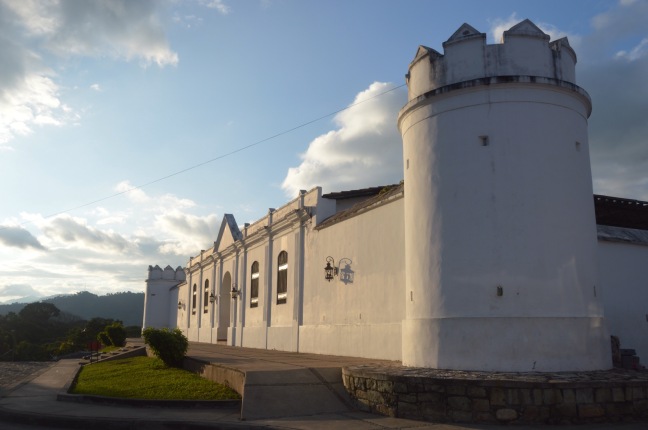I had allocated the day to explore the famous Mayan ruins of Copan, after which this town was named. The view from the cafe next door bewitched me the previous evening, so I headed back there for a delicious breakfast topped off with a side of sumptuous scenery. Unfortunately, I wasn’t the only one dining as I discovered dozens of tiny dried dots of blood on both ankles and on the backs of both legs. I soon discovered the source of this mystery was tiny little midgies I had given little credence to at the time. By the time I left, the the dots had swollen into large, angry lumps which I knew would plague me for days to come.

The weather had turned and it was drizzling when I left. Water on steep cobbled road is never a preferable option but I found a route through the town that only had one steep downhill section and gingerly made my way down that. After that, it was a very pleasant kilometre stroll out past the town to the archeological site.

Copan Archaeological Site is a Unesco World Heritage Site. Though not the biggest nor most spectacular of the Mayan sites, Copan is exceptional due to the high relief sculptures and hieroglyphics found within its boundaries. I engaged the services of Gladiz, the gregarious guide, to interpret the site for me. Not only did Gladiz really know her stuff, she was lots of fun as well and I really enjoyed the tour. Even though I had visited many Mayan archeological sites previously, I found myself learning even more about this intriguing culture.

I already knew that the winning captain of the ball game played in the day was occasionally sacrificed for the gods and that was OK in the victim’s eyes. What I didn’t know, was that the unfortunate was heavily plied with hallucinogens before being submitted to the event. By this stage, he was probably one accident away from checking out of the mortal world anyway so a sacrifice to the gods wouldn’t have seemed such a bad option. The other thing I learned was that the Mayan of the day didn’t have names like Bruce or Jesus, but 18 Rabbit and Smoke Monkey. I’m thinking the hallucinogens probably had a hand in that too.

After an incredibly informative two hour guided tour, including some archeological tunnels exposing the Rosalila Temple which was built over the top of many Mayan moons ago, I bid Gladiz adios and continued wandering around the site taking photos and further exploring. The sacred Mayan bird, the scarlet macaw, has decided to take up residence again on the site and was a colourful addition. I also wandered down a couple of walking trails which lead through the jungle to some other sites, as well as visited the on-site Museum of Sculptures.

Finally, all Mayan-ed out, I wandered back into town to explore its hilly streets. The walk up to a local lookout point was particularly brutal in one section, but I was astounded to see a couple of locals pop up from a track I would have thought impossible to climb. I’m sure they must have been crossed with mountain goat in some stage of the evolution process. Still, it was lovely wandering around the town, trying to stay on top of the hill where possible. What goes down must go up! At some stage.

Back at the hostel, I had a by now much needed freshen up and went out to grab some street food in the form of burritos with a lovely Canadian family I had met at the hostel. Interestingly enough, our burritos were prepared by an expat Belizian Garifuna man who was now living in Copan. Not what I would have expected in a sleepy little Honduran highland town such as Copan Ruinas.

I was looking everywhere for a photo of the Macaw you mentioned!!
LikeLike
Haha. They were not very cooperative when it came to being photographed.
LikeLike
I’m loving reliving CA through your photos and blog. I loved Copan Ruins. Terrible difficult to get to on a motorcycle though. Eat while you can. Copan has the best selection of food for hundreds of miles in any direction.
LikeLiked by 1 person